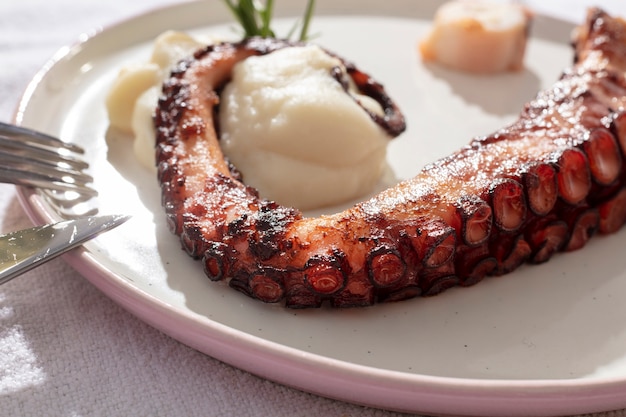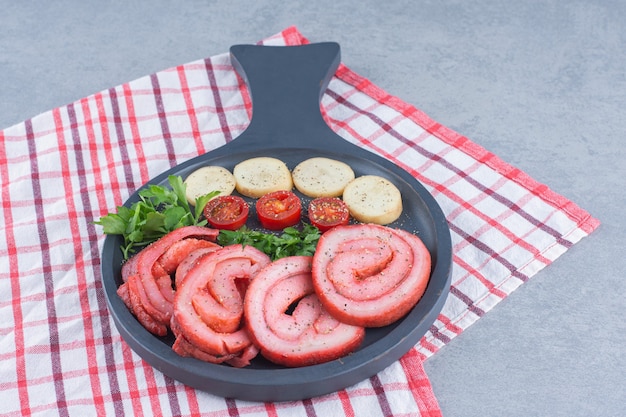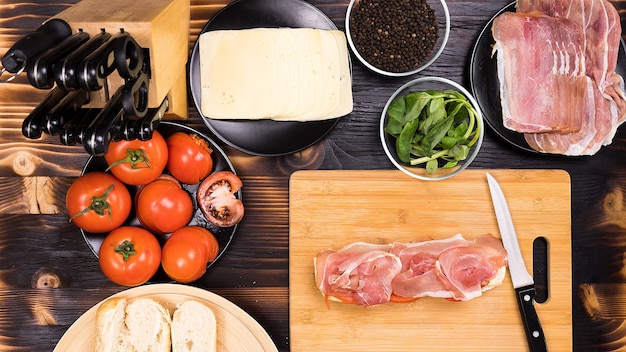(Part 1) Spiral Ham: A Quick Overview

The Types of Spiral Ham: A Variety to Suit Your Taste
Now, you'll find spiral hams come in a variety of styles. There's the classic bone-in ham, the bone-less version, and even hams with different flavourings - like honey-glazed or hickory-smoked. It can be a bit overwhelming, but don't worry. I'll help you navigate this delicious jungle.1. bone-in spiral ham: The Classic Choice
Bone-in spiral ham is the traditional and often preferred choice. It offers a richer flavor and a more robust texture, especially when the bone is used for roasting. However, it's also a bit more challenging to carve.2. Bone-Less Spiral Ham: Convenience at its Finest
Bone-less spiral ham is a great option for those who prefer convenience. It's easier to carve and can be cooked directly in a baking dish. But keep in mind that it may not have the same depth of flavor as bone-in ham.3. Flavored Spiral Ham: A Ready-Made Indulgence
Flavored spiral hams are often pre-cooked and come in a variety of flavors. You'll find honey-glazed, hickory-smoked, maple-glazed, and even pineapple-glazed varieties. They can be a convenient and delicious option, but they may not offer as much flexibility for customization.Spiral Ham: A Brief History: From Butcher's Innovation to Culinary Staple
Did you know that spiral slicing was actually invented by a butcher in the 1950s? Imagine that! He was simply trying to find a way to make ham more appealing to customers, and voila! A culinary game-changer. This clever invention made it possible for us to enjoy the succulent flavours of ham in a convenient and visually striking way.(Part 2) Preparing Your Spiral Ham: A Step-by-Step Guide

1. Choosing the Right Ham: The First Step to Success
The first step is choosing the right ham. It's crucial to pick one that's fresh and has a good colour. If you're going for a pre-cooked ham, look for one that's moist and has a nice pink colour. Avoid any hams that look dry or discolored. You can also ask your butcher for advice. They're often a wealth of knowledge, and they might even have some excellent suggestions for the perfect glaze.2. Removing the Packaging and Patting it Dry: A Clean Slate for Flavor
Right, so you've got your gorgeous spiral ham, and now it's time to get it ready for the oven. I always like to remove any packaging that it comes in and give it a good pat dry with some paper towels. This helps to get rid of any excess moisture, which can make the ham steam instead of crisping up nicely.3. Scoring the Fat: Bringing Out the Flavor
Now, for the scoring. This step is important because it helps the glaze to penetrate the ham and allows the fat to render, resulting in a beautifully crispy crust. Use a sharp knife to make diagonal cuts about 1/4 inch apart across the fat layer. Be careful not to cut too deep! You just want to score the fat, not the meat. Scoring also helps to prevent the fat from bubbling up during cooking.4. Setting the Stage: Choosing the Right Baking Dish
Next, you'll need a baking dish that's big enough to hold your ham comfortably. I find a roasting pan works well, but you can also use a dutch oven. You can also line the dish with parchment paper for easy clean-up, but honestly, I just don't bother with that step. A quick scrub with a sponge later does the trick!(Part 3) Cooking Your Spiral Ham: A Symphony of Flavors

1. Heating Your Oven to the Right Temperature: Finding the Sweet Spot
The first thing to do is to preheat your oven to 325°F (160°C). This temperature is perfect for gently heating the ham through and allowing the glaze to melt and caramelize beautifully.2. Placing the Ham in the Oven and Adding Liquid: A Little Help from the Bottom
Now, carefully place your ham in the baking dish and add about a cup of water to the bottom of the pan. This helps to create steam, which keeps the ham moist and prevents it from drying out. Don't worry about adding too much water - the ham will absorb it as it cooks.3. The Timing Game: How Long to Cook a Spiral Ham
The cooking time for a spiral ham really depends on the size. A small ham might only need 30-45 minutes, while a larger one might take an hour or even more. I always check the package instructions for the exact time, just to be safe. A meat thermometer will be your best friend here, ensuring the ham is cooked through without becoming dry.4. Adding the Glaze: A Final Touch of Sweetness
With about 20 minutes left, it's time to add the glaze. Now, I've got a confession. I'm not a big fan of store-bought glazes. They can be a bit too sweet for my liking. I like to make my own, using ingredients like honey, brown sugar, and mustard. I'll tell you more about my favourite glaze later.5. Basting the Ham: A Little TLC
To help the glaze stick, it's important to baste the ham with a pastry brush every 15-20 minutes. Just spoon the glaze over the ham and make sure to coat it evenly. This helps to create a beautiful, glossy finish and really brings out those flavors.6. Checking for Doneness: A Little Patience and a Meat Thermometer
Now, you're nearly there! But it's always a good idea to check the internal temperature of the ham to make sure it's cooked through. The safe internal temperature for ham is 145°F (63°C). A meat thermometer will come in handy here.(Part 4) Glazing Your Spiral Ham: The Art of Sweetness
Now, let's talk about the glaze. This is where you can really get creative and add your own personal touch. I mentioned earlier that I don't usually use store-bought glazes. I prefer to make my own, and here's why:- Control over the Ingredients: I can use ingredients that I know and love, and adjust the sweetness and flavour to my liking.
- Fresh and Delicious: Homemade glazes are bursting with fresh flavor. You'll be able to taste the difference.
- Creative Freedom: It's an opportunity to experiment with different combinations and create something truly unique.
A Few Glaze Ideas:
Here are a few of my favourite homemade glaze recipes, offering a variety of flavor profiles to suit your taste:1. honey-mustard glaze: The Classic
- 1/2 cup honey
- 1/4 cup Dijon mustard
- 1/4 cup brown sugar
- 2 tablespoons apple cider vinegar
Whisk all the ingredients together until smooth. This glaze is both sweet and tangy with a lovely golden colour. It's a classic for a reason!
2. pineapple glaze: A Tropical Twist
- 1/2 cup pineapple juice
- 1/4 cup brown sugar
- 2 tablespoons soy sauce
- 1 tablespoon cornstarch
Mix all the ingredients together in a saucepan over medium heat, stirring constantly until the glaze thickens. This glaze gives the ham a delightful tropical twist.
3. Maple-Bourbon Glaze: A Touch of Sophistication
- 1/2 cup maple syrup
- 1/4 cup bourbon
- 1/4 cup Dijon mustard
- 1 teaspoon ground ginger
Combine all the ingredients in a saucepan over medium heat and simmer for 5 minutes, or until the glaze thickens slightly. This glaze is rich, complex, and oh-so-delicious.
4. Cherry-Chipotle Glaze: A Smoky Sweetness
- 1/2 cup cherry preserves
- 1/4 cup adobo sauce from canned chipotle peppers
- 1 tablespoon brown sugar
- 1/2 teaspoon smoked paprika
Mix all the ingredients in a saucepan over medium heat and cook until the glaze is thick and bubbly. This glaze offers a unique blend of sweet and smoky flavors, perfect for those who enjoy a bit of spice.
(Part 5) Resting Your Spiral Ham: A Crucial Step
Okay, your spiral ham is finally cooked and glazed to perfection! But we're not quite finished yet. Resting the ham is an important step that allows the juices to redistribute throughout the meat, resulting in a juicier and more flavorful ham. It's a bit like giving the ham a little break after all that hard work!I usually let the ham rest for about 10-15 minutes before carving it. It might feel like a long time, but it's worth it, I promise. During this time, I like to take a moment to admire the beautiful, glistening glaze and think about all the happy faces that will be enjoying it.
(Part 6) Carving Your Spiral Ham: A Culinary Performance
Right, the moment has come. It's time to carve that gorgeous spiral ham. I'll admit, I sometimes get a little nervous about this part. But trust me, it's really not that hard. You just need a sharp knife and a steady hand.I like to carve the ham right on the serving platter. This way, I can easily transfer it to the table without messing up anything.
Tips for Carving a Spiral Ham
- Use a Sharp Knife: A dull knife will make it much harder to carve the ham cleanly and could even tear the meat. A sharp, serrated knife is ideal for slicing through the ham's layers.
- Work Slowly and Carefully: There's no need to rush. Just take your time and be patient. You'll be able to carve the ham beautifully.
- Cut Against the Grain: Cutting against the grain helps to make the ham more tender and easier to chew. Look at the texture of the meat and try to identify the direction of the grain. The slices will be more even and less stringy if you cut against the grain.
- Start at the End: Begin carving at the end of the spiral, carefully removing slices from the thickest part of the ham.
(Part 7) Serving Your Spiral Ham: A Feast for the Senses
And there you have it! Your perfectly cooked, beautifully glazed, and meticulously carved spiral ham. Now, it's time to serve it up and enjoy all that hard work. I always serve my spiral ham with a medley of sides. It's all about balance, you know?Here are some of my favourite sides for spiral ham, offering a combination of textures and flavors to complement the main course:
Delicious Sides for a Spiral Ham Feast
- Creamy mashed potatoes: They're the perfect comfort food to go with a savory ham. The creamy texture contrasts nicely with the slightly salty ham, creating a satisfying balance.
- Glazed Carrots: The sweetness of glazed carrots complements the salty ham beautifully. A bright, colorful addition to your table.
- green bean casserole: This classic side dish is always a crowd-pleaser. It adds a bit of nostalgia and a savory, creamy element to the meal.
- sweet potato Casserole: This is another delicious side that adds a touch of sweetness to the meal. The sweet potato adds a rich and comforting flavor, contrasting with the savory ham.
- roasted asparagus: A more elegant and lighter option for those who prefer a less heavy side dish. It's a simple but elegant accompaniment.
- Mac and Cheese: A crowd-pleasing side that goes well with a wide range of dishes. The creamy and cheesy flavors complement the ham nicely.
- Cranberry Sauce: A traditional holiday side that adds a touch of tartness and sweetness to the meal. It's a classic pairing with spiral ham.
(Part 8) Storing Leftover Spiral Ham: Keeping the Feast Alive
Okay, so you've cooked up a storm, everyone's had their fill, and you're left with a little bit of leftover spiral ham. Don't worry, it's time to get creative!You can refrigerate leftover ham for up to 4 days, or freeze it for up to 2 months. I find that wrapping it tightly in plastic wrap or foil helps to prevent freezer burn.
Ways to Use Leftover Ham:
Here are a few ideas for using leftover spiral ham, transforming it into delicious new dishes:- ham and cheese sandwiches: It's a classic for a reason! It's simple, delicious, and everyone loves it.
- Ham and bean soup: This hearty soup is perfect for a chilly day. The ham adds a smoky flavor and depth to the soup.
- Ham and Potato Hash: This is a quick and easy breakfast or lunch dish. The ham adds a savory element to the hash.
- Ham Quiche: A little bit of leftover ham adds a lovely savory flavor to a quiche. It adds a nice richness and depth to the quiche filling.
- Ham fried rice: A simple and satisfying way to use up leftover ham. The ham adds a savory element to the fried rice.
- Ham and Pineapple Pizza: A sweet and savory combination that is sure to please. The ham and pineapple create a unique and delicious topping for pizza.
- Ham Salad Sandwiches: A classic sandwich filling that can be used on sandwiches, wraps, or salads. The ham adds a savory and salty flavor to the salad.
(Part 9) FAQs: Your Spiral Ham Questions Answered
Now, I know you might have some questions about cooking spiral ham, so let's address those.1. Can I Cook a Spiral Ham From Frozen?
It's not recommended to cook a spiral ham from frozen. The ham will take much longer to cook and may not cook evenly. It's best to thaw it completely in the refrigerator before cooking. Thawing in the refrigerator ensures that the ham thaws evenly and safely, preventing bacterial growth.
2. What Happens if I Overcook the Ham?
Overcooked ham can become dry and tough. If you think you might have overcooked the ham, you can try adding a little more liquid to the bottom of the baking dish and basting it with more glaze. This can help to add some moisture back into the ham, but it's best to avoid overcooking in the first place.
3. How Can I Make the Ham Even More Flavorful?
A great way to add extra flavor is to use a flavorful glaze, or to add some extra ingredients to your glaze. For example, you could add a few cloves of garlic, a pinch of red pepper flakes, or a splash of orange juice. You can also try adding a few sprigs of rosemary or thyme to the baking dish while the ham cooks.
4. What Can I Do if the Ham Doesn't Have Enough Glaze?
Don't worry! You can add more glaze to the ham while it's resting. Simply brush on a little extra glaze and let it sit for a few minutes. The glaze will melt and become nice and sticky.
5. What's the Best Way to Store Leftover Ham?
It's best to store leftover ham in the refrigerator for up to 4 days. You can wrap it tightly in plastic wrap or aluminum foil. For longer storage, you can freeze it for up to 2 months. Just make sure to wrap it tightly to prevent freezer burn.
(Part 10) Final Thoughts: A culinary adventure
And there you have it, my friends! The ultimate guide to cooking a spiral ham. It's a journey, really, from choosing the perfect ham to carving it with a flourish and serving it up with pride. I hope you've enjoyed this adventure with me. Now, go forth and conquer the spiral ham, and most importantly, have fun with it! I'm sure you'll be creating delicious memories that will last a lifetime. Remember, the key is to relax, experiment with flavors, and enjoy the process. You've got this!Everyone is watching

How to Cook Frozen Lobster Tails Perfectly: A Step-by-Step Guide
RecipesLobster. Just the word conjures up images of lavish meals, special occasions, and a taste of luxury. But let's...

Pigs in a Blanket Cooking Time: How Long to Bake for Perfect Results
RecipesAh, pigs in a blanket. Just the name conjures up images of those delightful little parcels of crispy pastry en...

Pork Fillet Cooking Time: How Long to Cook It Perfectly
RecipesPork fillet, or tenderloin as it's sometimes called, is a real favourite in our house. It's so versatile, and...

The Ultimate Guide to Cooking Delicious Frankfurters
RecipesLet's face it, we all love a good frankfurter. It's a classic, simple, and always satisfying. But let's be rea...

Wolf Meat Recipes: A Guide to Cooking Wild Game
RecipesLet's be honest, you don't see wolf meat at your local butcher shop every day. It's a bit of a wild card, but ...
